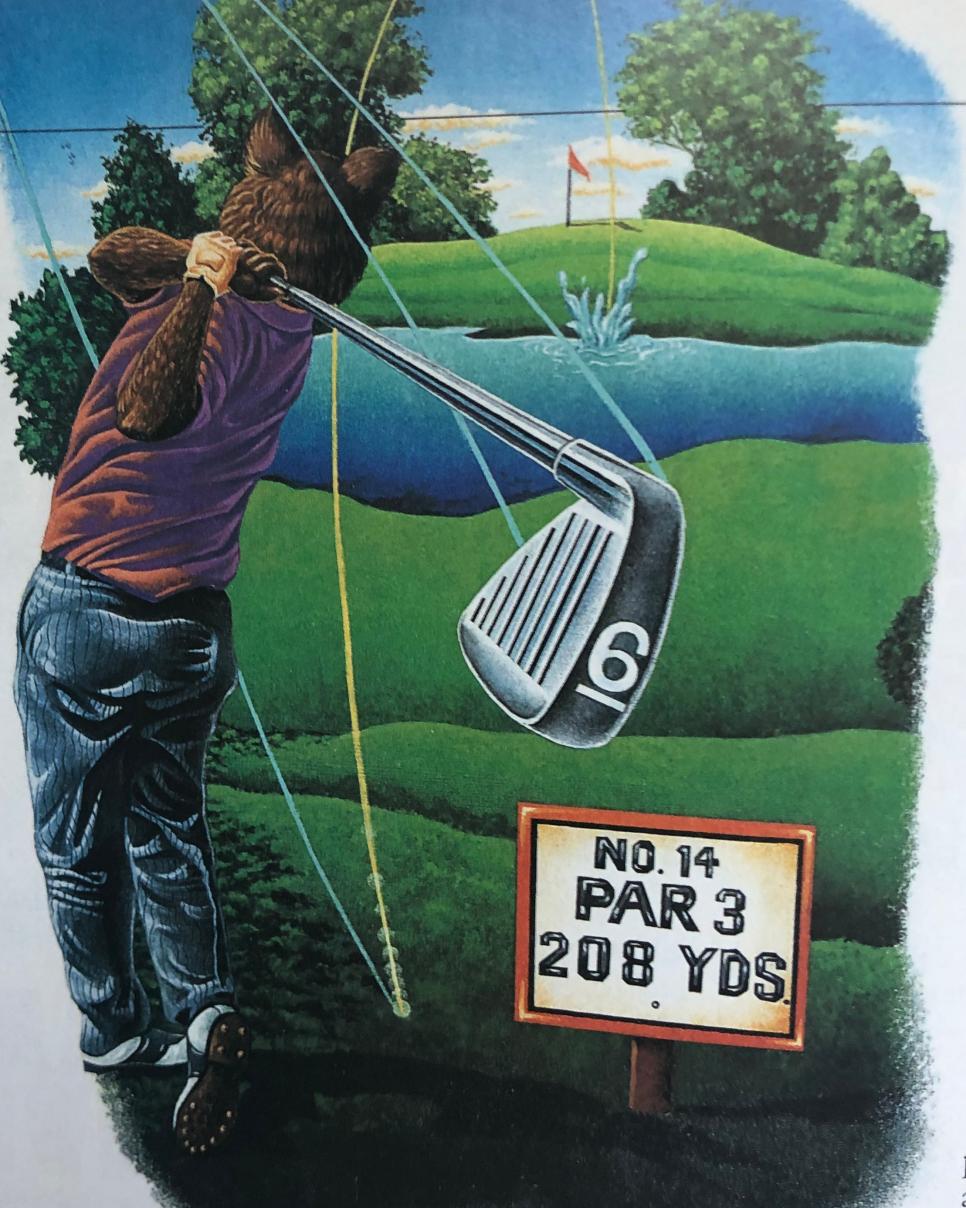News
Dirty little secrets of a sandbagger
From the archive (September 1995): Whenever this Texas hustler wanted to take a few skins off his opponents, he would rely on this batch of nasty golf tricks

Editor’s note: In celebration of Golf Digest's 70th anniversary, we’re revisiting the best literature and journalism we’ve ever published. Catch up on earlier installments.
“Sandbagging” has nothing to do with stacking bags of sand on a riverbank to protect against flooding. It actually derives from a 19th-century offensive tactic of hoodlums using a sock filled with sand to bludgeon a victim and steal his money. In poker the term applies to a player with strong cards who holds back his bets to draw in weaker hands until raising the stakes in the last round. It’s also used in racing for competitors who mask their true performance. But the most common application today is for golfers with inflated handicaps.
Golf Digest tackled the subject in many ways over the years, but only once with a full frontal assault. Senior Writer Guy Yocom met the author of this piece at a Dan Jenkins Partnership tournament at the now-defunct Z Boaz Golf Course in Fort Worth, a charming muny filled with characters reminiscent of Dan’s novel, Dead Solid Perfect. The Sandbagger and his partner won the event with a fairly outrageous score, and the manner in which they accepted their prizes—very blasé, like they did it every day—tempted Yocom to join them for a beer.
“Into our fourth Budweiser [and second cigar], I asked how they did it,” Guy explains. “The most garrulous of the two came clean, and the story I ghosted for him is really a master class. I ended up playing in several tournaments with him at his home club, where sandbagging was impossible. He’s scrupulously honest in other walks of life and insisted he fudged his handicap mainly to survive. The scene in Texas was so rife with sandbagging that he simply refused to be what he calls a ‘flight-filler’—a gullible player who donates his money to the field. Nobody at his home course seemed particularly offended or outraged by his antics. They accepted that in the Wild West of the low-net tournament scene, if you weren’t cheating, you weren’t trying.” This story first appeared in September 1995 and, as far as we know, the author is still out there, so beware. —Jerry Tarde
As told to Guy Yocom
Most people classify sandbagging on a handicap as outright cheating, but I’m not so sure. Cheating is carrying a tube of Chapstick in your pocket and whipping it out on the tee of a long, tight par 4 with water running down the right side. You grease up your lips, put the tube back in your pocket, pull your driver from your bag, and wipe your bottom lip with your forefinger. Then you discreetly brush that greased-up finger across the clubface of the driver. That little film of lubricant makes it impossible to slice the ball into the drink.
Or the guy I knew from Houston who always griped about the course being in lousy condition. He would suggest on the first tee that we play the ball “up,” so you may bump it in your own fairway. He always carried a roll of LifeSavers, which we didn’t regard as suspicious until the day we caught him tossing one on the ground next to his ball. We watched him roll his ball up on top of that LifeSaver, and it made the prettiest little tee you ever saw. He preferred the lime-flavored kind, so the green blended in with the grass. In winter, when the Bermuda grass went dormant, he’d use butter-rum.
Now THAT’S cheating. Sandbagging is quite a different thing. I did it for years on the Texas golf “barbecue circuit,” for reasons of economic survival. There are scores of small amateur tournaments around the state, and handicap hustling on this “tour” is a way of life. From Sherman to Paris, from Tyler to Longview, you either play with an inflated handicap or just donate your entry fee to the guys who do.
I don’t play in those tournaments much anymore, and the 6-handicap I carry today is strictly on the level. I’ve outgrown that scene. I’m in my 30s now. I belong to one of the best country clubs in the Dallas-Fort Worth metroplex. I’ve made a pile of money in my line of work and don’t need any more sets of new irons, golf bags, shotguns or Waterford crystal—which, incidentally, I always hated winning because I had trouble bartering with it.
Why am I coming clean? Well, I never was very dirty to begin with. In those days I was a legitimate 9-handicapper who doctored my number up to a 13. My conscience was not a problem. You have to know the Texas golf environment to understand that. It’s a big state, and the handicap police were totally outgunned. By fudging on my handicap by three or four shots, I did not win everything I played in. There were plenty of 10-handicappers masquerading as 18s who made bigger hauls than I did. I genuinely felt that if I played my best, I deserved to be competitive. And I was. But I lost a lot, too, so it was a wash.
If you think you know all the ways a shrewd handicap operator works, you don’t. The methods are so devious, so subtle, that he not only avoids detection, he avoids SUSPICION as well.

Before sandbagging can be addressed sufficiently to put guys like me out of business, the handicap police have a few things to learn:
Slope doesn’t work. Like I said, my 6-handicap today is as pure as a newborn foal. But if you take me from my course, which is one of the most difficult in the nation, and put me on a short, fast dog track, I’m going to clean house. Why? Because Slope doesn’t handle guys like me very well. It DOES work well for poorer players. A 24-handicapper who plays at a tough course might be lowered to a 20 when he travels to an easy course. But me, I’m going to be lowered two shots at the most, and that’s not enough. My home course is at least six shots harder than most courses that Slope tells us are only two shots harder. With my distance off the tee and my overall know-how, I’ll kill the par 5s and make dog meat of the short par 4s.
To further this point, how often does a player from an easy course eat up a long, hard course? Almost never, even with the extra shots through Slope. I play for low-gross prizes now, but teeing it up on an easy course is the one way a low-handicapper can garner net booty.
Sandbaggers love resort courses. There’s a resort course in Dallas that has maybe 350 names in the handicap computer. It reads like a most-wanted list of handicap hustlers. Why? Lack of internal policing. Resort courses are a transient, factory environment where hardly anybody knows one another. There are few circles of friends to police each other, and the handicap chairman and head pro are helpless because they don’t know anybody, either. At a lot of resort courses, shady characters stand in line to load the most preposterous scores you can imagine into the computer. My handicap basically was anything I wanted it to be.
The scope of the resort-course sandbagging problem is enormous, and this lack of “peer review” is entirely to blame. In the old days, when golfers posted their scores with pencils on computer readout sheets, everyone could readily see what everybody else was doing. Nowadays, with the computer, the player’s scoring history is, to a large extent, “hidden.”
The bottom line on resort courses is this: When you ask somebody, “Where do you play?” and they answer “I’m not a member anywhere but my handicap is at --- Resort,” keep your wallet in your pocket.
The member-guest tournament committee is verifying handicaps? Who cares? If you find solace in the promise that “each and every handicap will be investigated by phone calls to the guest’s home course,” don’t rest so easy. It never scared me. Who makes the phone calls? Rarely is it the head pro, who is busy handling some of the event’s bigger details. It’s usually the assistant pro, who is underpaid and overworked. And who’s answering on the other end? You got it—the assistant pro. He might verify that Mr. Tony Silica has a Handicap Index of 11.6, but he isn’t likely to say, “Mr. Silica is also a member at Groveling Badger; you might want to check over there.”
The sandbagger avoids the high-profile tournaments. The Dallas Morning News lands on my doorstep every day. I take special interest on Mondays, when area golf results are posted, showing who’s winning what, with what score. In my glory days, you would have had a hard time finding my name.
Why would I play in a huge, well-publicized tournament that features a dinner dance and tee prizes when I can play in a smaller tournament that still offers the maximum merchandise prize allowed by the USGA? Newspapers are poison, man, and every good sandbagger knows it.
Nowadays, I don’t just look at results. I look at pairings, too, especially when it’s a pro-scratch tournament. In a pro-scratch, the amateur has to play without handicap strokes. So if a pro I know has grabbed a 9-handicapper for a partner, I know that 9 is really a 4 or better.
The sandbagger plays the computer like a cheap violin. Ultimately, handicaps come down to what scores are entered into the computer. Accomplished sandbaggers know a lot of ways to get around posting low scores that will make their handicaps drop. If possible, they’ll try to avoid posting scores entirely, usually by going into the “four corners defense” in the taproom after the round. They’ll talk a lot, settle the bets, buy a few rounds of drinks and turn the topic to anything other than golf. After a few beers, I found that my pals often had forgotten about the round entirely, and I could slip out the door with the scorecard in my back pocket.

There are more sophisticated methods. Look at the suspected sandbagger’s scoring history. Is there a preponderance of “away” scores? I never played a strange course without grabbing a handful of cards on my way out, and I wasn’t shy about forging them. It’s rare when a handicap chairman actually calls you out on the carpet. Golf is a “gentleman’s game,” you see, and people in authority are reluctant to make waves.
Also, the smart sandbagger does not just monitor what’s going IN the computer, he knows what’s going OUT. He knows posting a 76 isn’t such a bad thing, if at the same time he’s pushing a 74 out of the computer. He also knows the posting dates for handicaps, so he can tweak them just before a beefy, cash-rich tournament.
The art of tanking golf shots. If you’re getting hammered for 15 holes by a guy who has no business playing as well as his handicap indicates, watch him closely the last three holes. When he begins to miss clearing hazards by inches and putts start grazing the left edge of the hole, you know you’ve been had.
He is discreet. He doesn’t hit rainbow slices into the woods or start three-putting from 10 feet. He’s much more subtle. On a par 3 over water, he’ll hit a beautiful 6-iron when a 5-iron was required to reach dry land. Then he’ll stand there with his hands on his hips like he can’t believe what he’s seeing. On the putting green, he’s especially clever. He’ll lag a 40-footer to within three feet, take his time and miss the short putt—ALWAYS pulling it, because a pull is easier to fake than a push.
In my prime, there were two occasions when I’d go into the tank: at the end of the round or for the whole round. If the entry fee was light and I got off to a bad start, I would sometimes tank the whole round, knowing that the money I lost that day would be recouped threefold in the next tournament.
“Hey, that Phil Nicholson is some kind of player!” The sandbagger who dresses like a pro and has the best equipment attracts too much suspicion. The hustler who lasts emulates the guy I went up against in a tournament in Kansas last year. He wore plaid Bermuda shorts, knee-high athletic socks with stripes around the top and leather golf shoes with kilties. He carried beat-up irons and a “name” driver, but the driver was 10 years old. He lugged his bag so it hung down in front of him. He said his favorite golfer was Phil “Nicholson,” with Paul “Azing-jur” a close second. He was not an authority on anything—not the rules, equipment or the golf swing.
I thought he was a loser. Then, early in the round, I noticed he had fresh, tacky grips on his old clubs. Most telling, he had a classic putter with gauze around the grip. He took his glove off to putt. I knew right then I was about to see Van Gogh in action. And I did. He shot a gross 72 (net 60) and won the net division going away. Remember, the best sandbagger does not dress or talk the part of a “real golfer.”
Two handicaps mean double trouble. There’s a guy in Fort Worth who has two handicaps at the SAME COURSE. All he did was change one letter of his last name. The guys at his club know which handicap is legitimate (it’s the lower of the two), but when he travels, you know which handicap he’s taking with him.
I never did this, but I saw plenty of it. Be especially wary of someone who carries handicaps in two states. If he winters in Florida but spends summers in New England, there might be a fox in the hen house.
Is his handicap between 10 and 18? That’s the prime sandbagging range. A 24-handicapper who plays to a 16 is easy to spot because there’s too much disparity between those talent levels. It’s the same thing with a 9-handicapper who plays to a 3; all you have to do is watch the flight of his ball.
The guy who is tough to nail is the 16 who plays to an 11. He’ll tell you he’s just having a good day, and the quality of his game makes it hard to question him on it. In the 10-to-18 range, the line between skill and luck is blurred. It also is the range where handicaps are most easily manipulated. An 11-handicapper on a bad day really does play like a 16, you see, whereas a scratch player rarely plays like an 8.
How much good my story does is open to question. The bottom line on sandbagging remains the same. If someone wants to manipulate his handicap, he’s going to find a way to do it. If you can solve that problem, you deserve a prize—low-gross division.